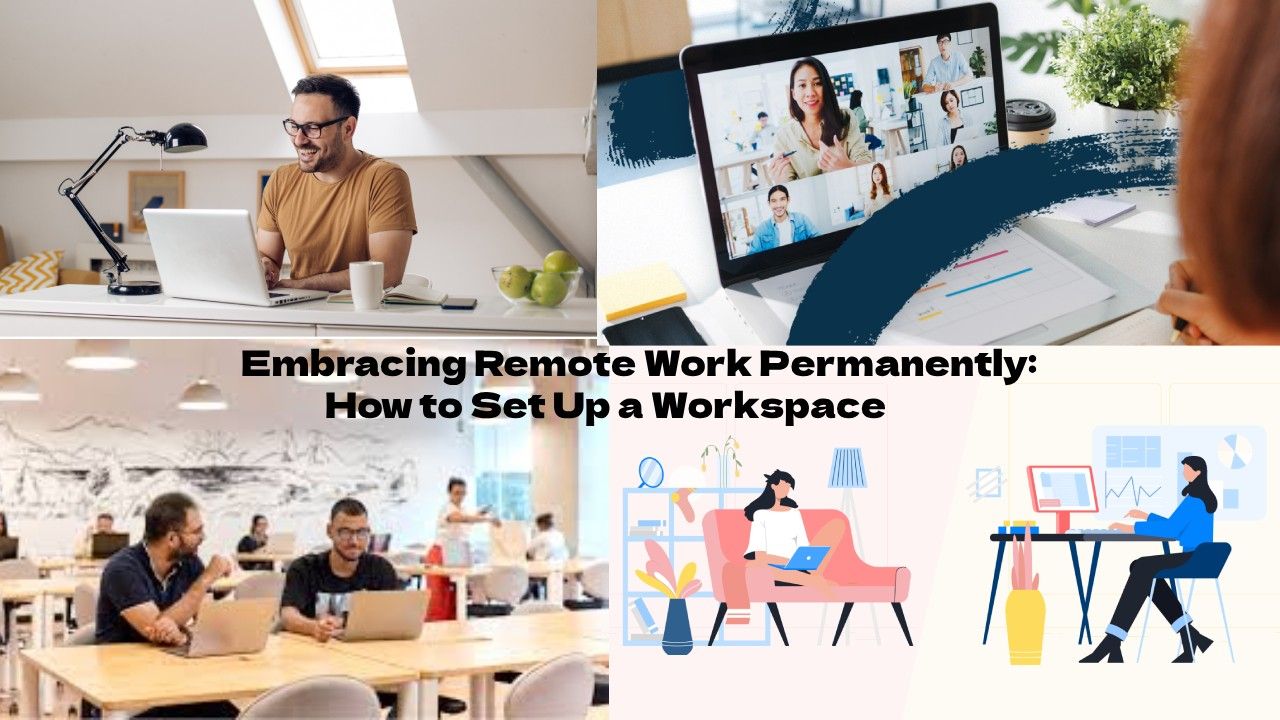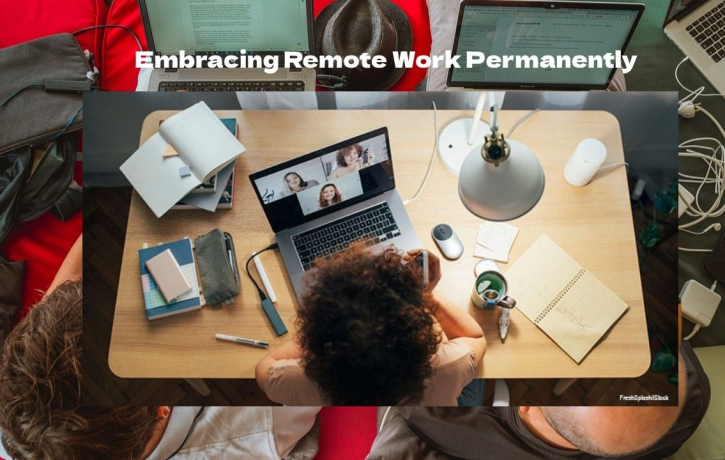- 1 The Shift to Remote Work: A New Era of Productivity
- 1.1 Step 1: Choose the Right Location for Your Home Office
- 1.2 Step 2: Invest in the Right Furniture and Equipment
- 1.3 Step 3: Optimize Your Technology for Remote Work
- 1.4 Step 4: Minimize Distractions
- 1.5 Step 5: Personalize Your Workspace for Comfort and Inspiration
- 1.6 Step 6: Maintain a Healthy Work-Life Balance
- 2 Conclusion: A Productive Remote Workspace for Long-Term Success

The way we work has undergone a transformation with the advent of remote work, and this trend is not going anywhere-it’s here to stay as part of the permanent evolution of the workplace. Companies must embrace flexible work arrangements and create an environment that allows for productivity, creativity, and balance. The only way for employees to be successful in the long run is by setting up a productive remote workspace. Here, we’ll be exploring how to optimize your home office for efficiency, comfort, and focus.
The Shift to Remote Work: A New Era of Productivity
The COVID-19 pandemic has pushed the envelope on remote work, and most companies have realized that letting employees work from home is a good thing. According to a report from Buffer, 97.6% of remote workers wanted to work remotely at least part-time for the rest of their careers. This statistic points to a great cultural shift where people want flexibility and the freedom to manage their own time.
With the rise of remote work here to stay, having a productive workspace that allows you to thrive while avoiding distractions and maintaining your focus is going to be important. But just how do you create this environment for efficiency and well-being? Let’s dive into the steps.
Step 1: Choose the Right Location for Your Home Office
The first move to setting up a productive remote workspace is choosing the right location within your home. This will play a major role in your ability to concentrate and separate work from personal life. Here are a few considerations:
Quiet and Comfortable: Find a space that is away from household noise and distractions. It could be a spare room, a corner in your living room, or even a cozy nook in your bedroom. The important thing is that it is quiet and comfortable enough for you to focus for long periods of time.
Natural Light: Natural light will significantly impact your productivity and mood. If possible, position your desk near a window to take advantage of sunlight, which can help reduce eye strain and improve focus.
Ergonomic Considerations: Ensure that the area you choose allows for an ergonomic setup. This is important for your physical well-being. Poor posture or sitting for long periods without proper support can lead to discomfort and even long-term health issues.
Step 2: Invest in the Right Furniture and Equipment
The right furniture and equipment are necessary to create a comfortable and efficient workspace. Your desk, chair, and tech tools can make or break your productivity.
Desk and Chair: An expensive desk is worth it in order to have ample space for your computer, notebooks, and other materials. Match this with an ergonomic chair that will help give your back lumbar support, which will keep your body straight and working for long periods without getting tired.
Monitor and Keyboard: While working on a laptop might be convenient, a larger external monitor can enhance your productivity by providing more screen real estate for multitasking. Additionally, pairing your monitor with an external keyboard and mouse can improve comfort and reduce strain on your wrists.
Headphones: In noisy environments or when one has to block out distracting sounds, noise-canceling headphones will help you maintain concentration. Headphones with an inbuilt microphone are ideal for virtual meetings and collaborations.
Lighting: Good lighting is important for productivity. Invest in adjustable task lighting, such as a desk lamp with warm light, to reduce eye strain during long working hours. Avoid harsh overhead lighting, which can create glare and lead to headaches.
Step 3: Optimize Your Technology for Remote Work
Technology is the backbone of remote work. A good internet connection and the right tools can significantly boost your productivity. Here’s what to consider:
High-Speed Internet: A fast, reliable internet connection is essential for video calls, file sharing, and staying connected with your team. If your internet speed is inconsistent, it may be worth upgrading your plan or investing in a Wi-Fi extender to improve coverage.
Software Tools: Choose the correct productivity and collaboration tool to stay organized and connect with the team. Platforms like Zoom, Microsoft Teams, Slack, and Google Drive can help you communicate effectively and keep your projects well-managed.
Cloud Storage: Cloud storage service allows storing files on a cloud server so that accessing work anywhere can be possible with devices connected to the internet.
Backup Power Supply: You would be wise to purchase an uninterruptible power supply (UPS) to ensure you don’t lose any data when the power is cut. A UPS keeps equipment going for as long as possible while you can save your work and properly shut down your computer.
Step 4: Minimize Distractions
One of the biggest challenges in working remotely is avoiding distractions. When your home turns into an office, it’s rather easy to get derailed while washing dishes or folding laundry, taken care of by a family member, or scrolling through social media. Here’s how to focus:
Set Boundaries: Establish clear boundaries with family members or roommates to minimize interruptions. Let them know your working hours and the importance of maintaining a quiet environment during those times.
Use Time Management Techniques: Consider using techniques like the Pomodoro Method, which involves working in focused 25-minute intervals followed by a 5-minute break. This can help maintain concentration and prevent burnout.
Turn off notifications: Turn off notifications from social media and other non-work-related apps. You can also use tools like Focus@Will or Freedom to block distracting websites during working hours.
Create a routine: Establishing a daily routine will help you stay disciplined and maintain a work-life balance. Start your day with a clear plan, and make sure to take breaks to refresh your mind and body.
Step 5: Personalize Your Workspace for Comfort and Inspiration
While functionality is important, your workspace should also reflect your personality and inspire you to work. A personalized workspace can help you feel more comfortable and motivated to complete tasks.
Decorate with a Purpose: Add elements that make your workspace feel comfortable and inviting. This could be plants, artwork, or inspirational quotes that keep you motivated throughout the day. Plants in particular improve air quality and reduce stress.
Organize and Declutter: A clean, organized workspace promotes a sense of calm and reduces mental clutter. Use storage solutions like filing cabinets, shelves, and drawer organizers to keep your workspace tidy and functional.
Incorporate Comfort Items: Small touches like a cozy blanket, a favorite mug, or a stress-relief toy can make your workspace feel more enjoyable and relaxing.
Step 6: Maintain a Healthy Work-Life Balance
One of the major benefits of remote work is the flexibility it provides. However, this flexibility can also blur the lines between personal and professional life. To maintain a healthy work-life balance:
Set Clear Working Hours: Set specific working hours to create structure in your day. When your work hours are over, shut down your computer and step away from your workspace to signal the end of your workday.
Take Breaks Regularly: Break is very important for staying focused and avoiding burnout. Get up, stretch, and move around every hour to refresh the mind and body.
Care for Self: Do not forget to take care of yourself. Schedule time for exercise, healthy meals, and relaxation to recharge for the next workday.
Conclusion: A Productive Remote Workspace for Long-Term Success
As remote work continues to shape the future of the workplace, creating a productive and comfortable home office is essential for sustained success. Selecting the right location, investing in quality furniture and technology, and minimizing distractions will set you up for productivity and focus. Personalizing your workspace and maintaining a healthy work-life balance will also contribute to your overall well-being. With the right environment and habits in place, you can embrace remote work permanently and thrive in this new era of work.








